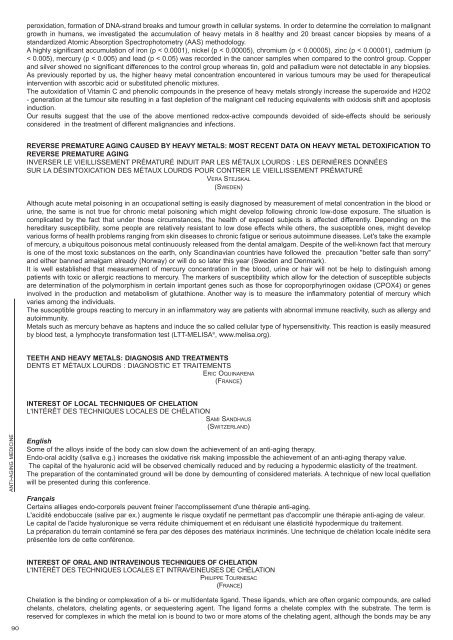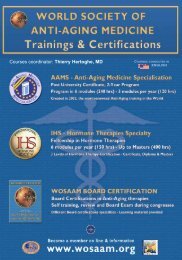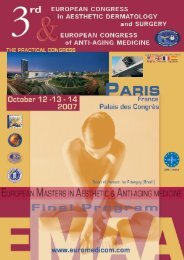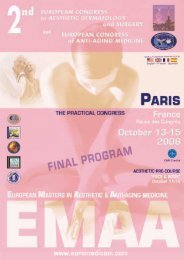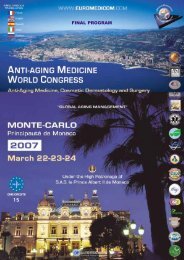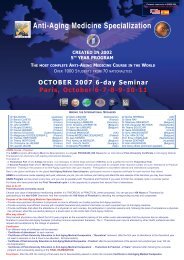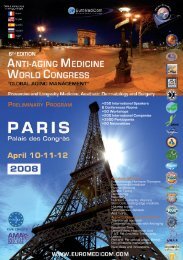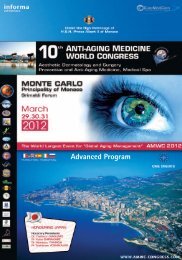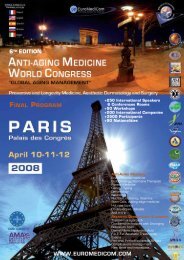FINAL PROGRAM 6TH EDITION - EuroMediCom
FINAL PROGRAM 6TH EDITION - EuroMediCom
FINAL PROGRAM 6TH EDITION - EuroMediCom
Create successful ePaper yourself
Turn your PDF publications into a flip-book with our unique Google optimized e-Paper software.
peroxidation, formation of DNA-strand breaks and tumour growth in cellular systems. In order to determine the correlation to malignantgrowth in humans, we investigated the accumulation of heavy metals in 8 healthy and 20 breast cancer biopsies by means of astandardized Atomic Absorption Spectrophotometry (AAS) methodology.A highly significant accumulation of iron (p < 0.0001), nickel (p < 0.00005), chromium (p < 0.00005), zinc (p < 0.00001), cadmium (p< 0.005), mercury (p < 0.005) and lead (p < 0.05) was recorded in the cancer samples when compared to the control group. Copperand silver showed no significant differences to the control group whereas tin, gold and palladium were not detectable in any biopsies.As previously reported by us, the higher heavy metal concentration encountered in various tumours may be used for therapeuticalintervention with ascorbic acid or substituted phenolic mixtures.The autoxidation of Vitamin C and phenolic compounds in the presence of heavy metals strongly increase the superoxide and H2O2- generation at the tumour site resulting in a fast depletion of the malignant cell reducing equivalents with oxidosis shift and apoptosisinduction.Our results suggest that the use of the above mentioned redox-active compounds devoided of side-effects should be seriouslyconsidered in the treatment of different malignancies and infections.REVERSE PREMATURE AGING CAUSED BY HEAVY METALS: MOST RECENT DATA ON HEAVY METAL DETOXIFICATION TOREVERSE PREMATURE AGINGINVERSER LE VIEILLISSEMENT PRÉMATURÉ INDUIT PAR LES MÉTAUX LOURDS : LES DERNIÈRES DONNÉESSUR LA DÉSINTOXICATION DES MÉTAUX LOURDS POUR CONTRER LE VIEILLISSEMENT PRÉMATURÉVERA STEJSKAL(SWEDEN)Although acute metal poisoning in an occupational setting is easily diagnosed by measurement of metal concentration in the blood orurine, the same is not true for chronic metal poisoning which might develop following chronic low-dose exposure. The situation iscomplicated by the fact that under those circumstances, the health of exposed subjects is affected differently. Depending on thehereditary susceptibility, some people are relatively resistant to low dose effects while others, the susceptible ones, might developvarious forms of health problems ranging from skin diseases to chronic fatigue or serious autoimmune diseases. Let's take the exampleof mercury, a ubiquitous poisonous metal continuously released from the dental amalgam. Despite of the well-known fact that mercuryis one of the most toxic substances on the earth, only Scandinavian countries have followed the precaution "better safe than sorry"and either banned amalgam already (Norway) or will do so later this year (Sweden and Denmark).It is well established that measurement of mercury concentration in the blood, urine or hair will not be help to distinguish amongpatients with toxic or allergic reactions to mercury. The markers of susceptibility which allow for the detection of susceptible subjectsare determination of the polymorphism in certain important genes such as those for coproporphyrinogen oxidase (CPOX4) or genesinvolved in the production and metabolism of glutathione. Another way is to measure the inflammatory potential of mercury whichvaries among the individuals.The susceptible groups reacting to mercury in an inflammatory way are patients with abnormal immune reactivity, such as allergy andautoimmunity.Metals such as mercury behave as haptens and induce the so called cellular type of hypersensitivity. This reaction is easily measuredby blood test, a lymphocyte transformation test (LTT-MELISA ® , www.melisa.org).TEETH AND HEAVY METALS: DIAGNOSIS AND TREATMENTSDENTS ET MÉTAUX LOURDS : DIAGNOSTIC ET TRAITEMENTSERIC OQUINARENA(FRANCE)INTEREST OF LOCAL TECHNIQUES OF CHELATIONL'INTÉRÊT DES TECHNIQUES LOCALES DE CHÉLATIONSAMI SANDHAUS(SWITZERLAND)ANTI-AGING MEDICINEEnglishSome of the alloys inside of the body can slow down the achievement of an anti-aging therapy.Endo-oral acidity (saliva e.g.) increases the oxidative risk making impossible the achievement of an anti-aging therapy value.The capital of the hyaluronic acid will be observed chemically reduced and by reducing a hypodermic elasticity of the treatment.The preparation of the contaminated ground will be done by demounting of considered materials. A technique of new local quellationwill be presented during this conference.FrançaisCertains alliages endo-corporels peuvent freiner l'accomplissement d'une thérapie anti-aging.L'acidité endobuccale (salive par ex.) augmente le risque oxydatif ne permettant pas d'accomplir une thérapie anti-aging de valeur.Le capital de l'acide hyaluronique se verra réduite chimiquement et en réduisant une élasticité hypodermique du traitement.La préparation du terrain contaminé se fera par des déposes des matériaux incriminés. Une technique de chélation locale inédite seraprésentée lors de cette conférence.INTEREST OF ORAL AND INTRAVEINOUS TECHNIQUES OF CHELATIONL'INTÉRÊT DES TECHNIQUES LOCALES ET INTRAVEINEUSES DE CHÉLATIONPHILIPPE TOURNESAC(FRANCE)Chelation is the binding or complexation of a bi- or multidentate ligand. These ligands, which are often organic compounds, are calledchelants, chelators, chelating agents, or sequestering agent. The ligand forms a chelate complex with the substrate. The term isreserved for complexes in which the metal ion is bound to two or more atoms of the chelating agent, although the bonds may be any90


